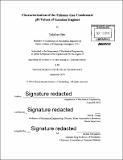Characterization of the exhaust gas condensate pH values of gasoline engines
Author(s)
Jain, Lakshya
DownloadFull printable version (7.821Mb)
Other Contributors
Massachusetts Institute of Technology. Department of Mechanical Engineering.
Advisor
Wai K. Cheng.
Terms of use
Metadata
Show full item recordAbstract
Exhaust Gas Recirculation has been used in gasoline engines to reduce NOx formation and part-load throttle loss for many years. More recently, there is a trend towards down-sizing and turbocharging engines as the strategy helps to improve fuel economy. Cooled low pressure EGR complements down-sizing-turbocharging in direct injection gasoline engines and has the potential to further improve efficiency. When exhaust gas gets cooled down below its dew point in an EGR cooler, the contained water vapor condenses on the cooler walls and dissolves some of the exhaust gases, which may make the condensate corrosive. For this reason, the extraction point for EGR is usually located downstream of the catalyst, where the gas that condenses with water has substantial amount of ammonia, making the condensate slightly basic but not corrosive. Following a recent study which showed potential fuel economy benefits of locating the EGR extraction point upstream of the catalyst, an understanding of the chemistry of pre-catalyst condensate is required. The feed gas to the catalyst contains NO, and other gases, which dissolve in the condensate to form acids. This study attempts to quantify the contribution of NOx, SOx and CO2 in the exhaust towards acid formation, in order to identify the cause of the acidity under different engine operating conditions. Theoretical calculations were done to predict the condensate pH for different air-fuel ratios and combustion phasing, for each gas separately and then together, assuming equilibrium between exhaust gas and condensate. Condensate pH was also measured experimentally for these running conditions to attempt to verify the calculations. Calculations show that the pH varies in the range 2 to 4. Contribution from SO, is the determining factor during rich operation; that from NO, is more important at stoichiometric and lean conditions. Actual pH values are generally less acidic than the calculated values and vary between 3 and 6. This discrepancy indicates that the dissolving of these gases into the condensate does not reach equilibrium. However, the calculated values may serve as useful bounds on the condensate pH.
Description
Thesis: S.M., Massachusetts Institute of Technology, Department of Mechanical Engineering, 2016. Cataloged from PDF version of thesis. Includes bibliographical references (pages 55-56).
Date issued
2016Department
Massachusetts Institute of Technology. Department of Mechanical EngineeringPublisher
Massachusetts Institute of Technology
Keywords
Mechanical Engineering.